power steering KIA RIO HATCHBACK 2012 Owners Manual
[x] Cancel search | Manufacturer: KIA, Model Year: 2012, Model line: RIO HATCHBACK, Model: KIA RIO HATCHBACK 2012Pages: 385, PDF Size: 9.68 MB
Page 5 of 385
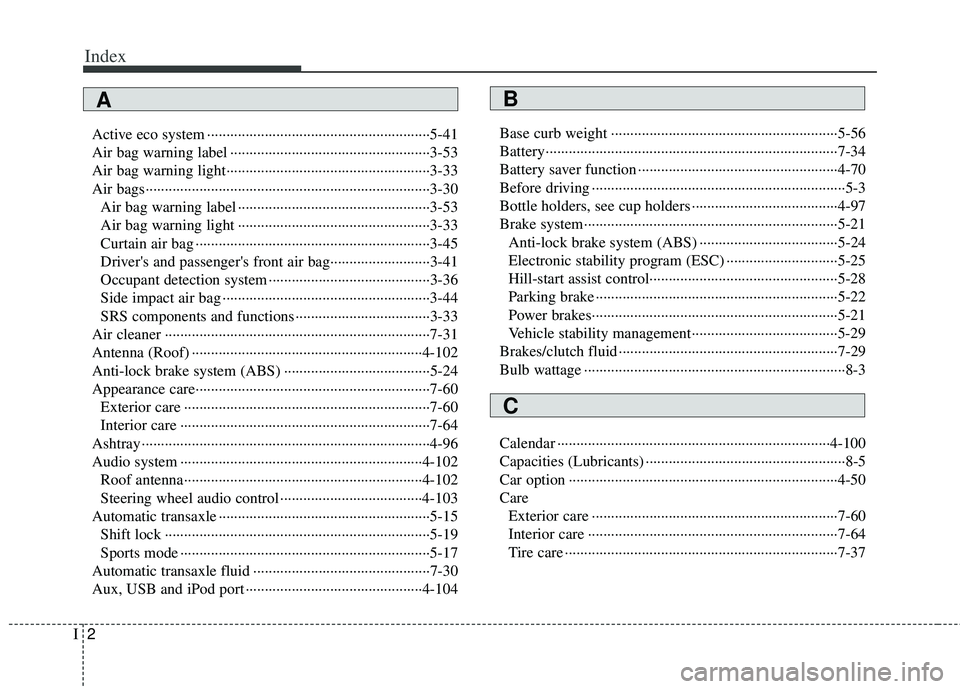
Index
2I
Active eco system ··················\
··················\
··················\
····5-41
Air bag warning label ··················\
··················\
················3-53
Air bag warning light··················\
··················\
·················3-33\
Air bags··················\
··················\
··················\
··················\
··3-30Air bag warning label ··················\
··················\
··············3-53
Air bag warning light ··················\
··················\
··············3-33
Curtain air bag ··················\
··················\
··················\
·······3-45
Driver's and passenger's front air bag··········\
················3-41
Occupant detection system ··················\
··················\
······3-36
Side impact air bag ··················\
··················\
··················\
3-44
SRS components and functions ··················\
·················3-33\
Air cleaner ··················\
··················\
··················\
···············7-31
Antenna (Roof) ··················\
··················\
··················\
······4-102
Anti-lock brake system (ABS) ··················\
··················\
··5-24
Appearance care··················\
··················\
··················\
·······7-60 Exterior care ··················\
··················\
··················\
··········7-60
Interior care ··················\
··················\
··················\
···········7-64
Ashtray ··················\
··················\
··················\
··················\
···4-96
Audio system ··················\
··················\
··················\
·········4-102 Roof antenna··················\
··················\
··················\
········4-102
Steering wheel audio control ··················\
··················\
·4-103
Automatic transaxle ··················\
··················\
··················\
·5-15 Shift lock ··················\
··················\
··················\
···············5-19
Sports mode ··················\
··················\
··················\
···········5-17
Automatic transaxle fluid ··················\
··················\
··········7-30
Aux, USB and iPod port ··················\
··················\
··········4-104 Base curb weight ··················\
··················\
··················\
·····5-56
Battery··················\
··················\
··················\
··················\
····7-34
Battery saver function ··················\
··················\
················4-70
Before driving ··················\
··················\
··················\
············5-3
Bottle holders, see cup holders ··················\
··················\
··4-97
Brake system··················\
··················\
··················\
············5-21
Anti-lock brake system (ABS) ··················\
··················\
5-24
Electronic stability program (ESC) ··················\
···········5-25
Hill-start assist control············\
··················\
··················\
·5-28
Parking brake ··················\
··················\
··················\
·········5-22
Power brakes··················\
··················\
··················\
··········5-21
Vehicle stability management··················\
··················\
··5-29
Brakes/clutch fluid ··················\
··················\
··················\
···7-29
Bulb wattage ··················\
··················\
··················\
··············8-3
Calendar ··················\
··················\
··················\
·················4-10\
0
Capacities (Lubricants) ··················\
··················\
················8-5
Car option ··················\
··················\
··················\
················4-50
Care Exterior care ··················\
··················\
··················\
··········7-60
Interior care ··················\
··················\
··················\
···········7-64
Tire care ··················\
··················\
··················\
·················7-37\
AB
C
Page 7 of 385

Index
4I
Economical operation ··················\
··················\
················5-42
Electric power steering ··················\
··················\
··············4-35
Electronic stability program (ESC) ··················\
·············5-25
Emergency starting ··················\
··················\
··················\
····6-4Jump starting ··················\
··················\
··················\
···········6-4
Push starting ··················\
··················\
··················\
············6-6
Emergency while driving ··················\
··················\
·············6-2
Emission control system ··················\
··················\
············7-66 Crankcase emission control system··················\
···········7-66
Evaporative emission control System ··················\
·······7-66
Exhaust emission control system ··················\
··············7-66
Engine ··················\
··················\
··················\
··················\
······8-2
Engine compartment ··················\
··················\
··················\
··2-4
Engine compartment panel fuse ··················\
··················\
7-58
Engine coolant ··················\
··················\
··················\
·········7-26
Engine coolcant temperature gauge··················\
·············4-43
Engine number ··················\
··················\
··················\
···········8-8
Engine oil ··················\
··················\
··················\
·················7-25\
Engine overheats ··················\
··················\
··················\
········6-7
Engine start/stop button ··················\
··················\
···············5-6
Engine will not start··················\
··················\
··················\
···6-3
Evaporative emission control System ··················\
··········7-66
Exhaust emission control system··················\
·················7-66\
Explanation of scheduled maintenance items ···············7-22
Exterior care··················\
··················\
··················\
·············7-60 Flat tire (with spare tire) ··················\
··················\
············6-13
Jack and tools ··················\
··················\
··················\
········6-13
Changing tires··················\
··················\
··················\
········6-14
Compact spare tire ··················\
··················\
··················\
·6-19
Removing and storing the spare tire···········\
·················6-14\
Flat tire (with tire mobility kit) ··················\
··················\
·6-21
Floor mat anchor(s) ··················\
··················\
·················4-10\
1
Fluid Automatic transaxle fluid ··················\
··················\
········7-30
Brakes/clutch fluid··················\
··················\
··················\
·7-29
Washer fluid··················\
··················\
··················\
···········7-30
Folding the outside rearviwe mirror ··················\
············4-40
Folding the rear seat ··················\
··················\
··················\
3-10
Front passenger and rear seat belt ··················\
···············3-16
Front seat adjustment ··················\
··················\
··················\
·3-4
Fuel filler lid ··················\
··················\
··················\
············4-28
Fuel gauge··················\
··················\
··················\
················4-43
Fuel requirements ··················\
··················\
··················\
······1-3
Fuses ··················\
··················\
··················\
··················\
······7-50 Engine compartment panel fuse ··················\
················7-52
Fuse/relay panel description ··················\
··················\
····7-54
Instrument panel fuse ··················\
··················\
··············7-51
Memory fuse··················\
··················\
··················\
··········7-51
Multi fuse ··················\
··················\
··················\
··············7-53
FE
Page 11 of 385
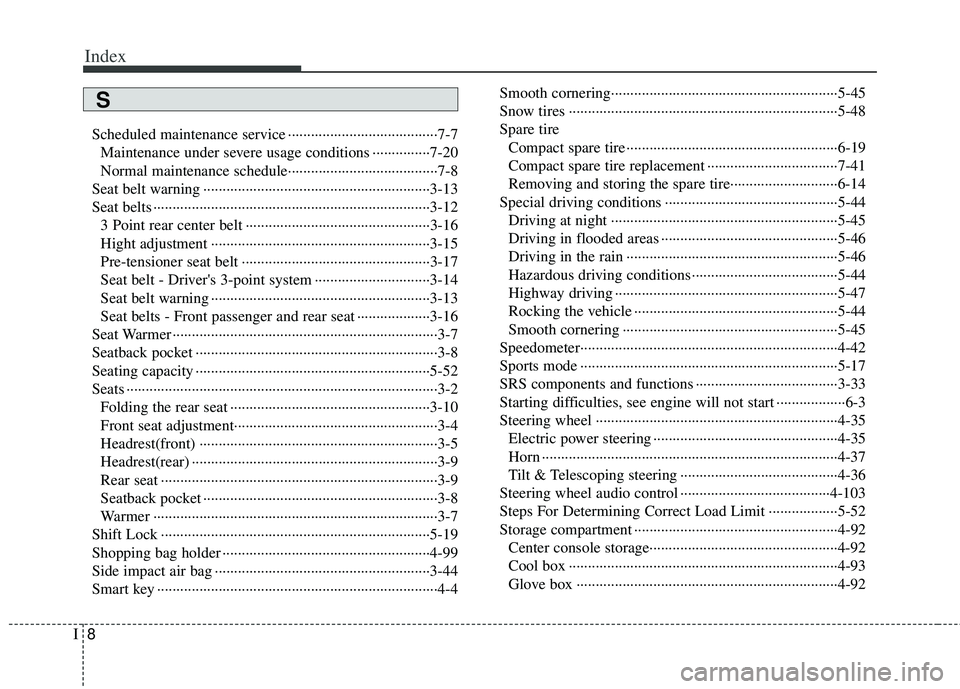
Index
8I
Scheduled maintenance service ··················\
··················\
···7-7Maintenance under severe usage conditions ···············7-20
Normal maintenance schedule··················\
··················\
···7-8
Seat belt warning ··················\
··················\
··················\
·····3-13
Seat belts ··················\
··················\
··················\
··················\
3-12 3 Point rear center belt ··················\
··················\
············3-16
Hight adjustment ··················\
··················\
··················\
···3-15
Pre-tensioner seat belt ··················\
··················\
·············3-17
Seat belt - Driver's 3-point system ··················\
············3-14
Seat belt warning ··················\
··················\
··················\
···3-13
Seat belts - Front passenger and rear seat ··················\
·3-16
Seat Warmer ··················\
··················\
··················\
···············3-7
Seatback pocket ··················\
··················\
··················\
·········3-8
Seating capacity ··················\
··················\
··················\
·······5-52
Seats ··················\
··················\
··················\
··················\
·········3-2 Folding the rear seat ··················\
··················\
················3-10
Front seat adjustment·············\
··················\
··················\
····3-4
Headrest(front) ··················\
··················\
··················\
········3-5
Headrest(rear) ··················\
··················\
··················\
··········3-9
Rear seat ··················\
··················\
··················\
··················\
3-9
Seatback pocket ··················\
··················\
··················\
·······3-8
Warmer ··················\
··················\
··················\
··················\
··3-7
Shift Lock ··················\
··················\
··················\
················5-19
Shopping bag holder ··················\
··················\
··················\
4-99
Side impact air bag ··················\
··················\
··················\
··3-44
Smart key ··················\
··················\
··················\
··················\
·4-4 Smooth cornering··················\
··················\
··················\
·····5-45
Snow tires ··················\
··················\
··················\
················5-48
Spare tire
Compact spare tire ··················\
··················\
··················\
·6-19
Compact spare tire replacement ··················\
················7-41
Removing and storing the spare tire···········\
·················6-14\
Special driving conditions ··················\
··················\
·········5-44 Driving at night ··················\
··················\
··················\
·····5-45
Driving in flooded areas ··················\
··················\
··········5-46
Driving in the rain ··················\
··················\
··················\
·5-46
Hazardous driving conditions ··················\
··················\
··5-44
Highway driving ··················\
··················\
··················\
····5-47
Rocking the vehicle ··················\
··················\
·················5-44\
Smooth cornering ··················\
··················\
··················\
··5-45
Speedometer··················\
··················\
··················\
·············4-42
Sports mode ··················\
··················\
··················\
·············5-17
SRS components and functions ··················\
··················\
·3-33
Starting difficulties, see engine will not start ··················\
6-3
Steering wheel ··················\
··················\
··················\
·········4-35 Electric power steering ··················\
··················\
············4-35
Horn ··················\
··················\
··················\
··················\
·····4-37
Tilt & Telescoping steering ··················\
··················\
·····4-36
Steering wheel audio control ··················\
··················\
···4-103
Steps For Determining Correct Load Limit ··················\
5-52
Storage compartment ··················\
··················\
·················4-92\
Center console storage·············\
··················\
··················\
4-92
Cool box ··················\
··················\
··················\
················4-93
Glove box ··················\
··················\
··················\
··············4-92
S
Page 18 of 385

15
Introduction
INDICATOR SYMBOLS ON THE INSTRUMENT CLUSTER
Seat belt warning light
High beam indicator
Turn signal indicator
ABS warning light
Parking brake & Brake fluid
warning light
Engine oil pressure warning light
ESC indicator
ESC OFF indicator
Malfunction indicator light
Air bag warning light
Immobilizer indicator
Low fuel level warning light* : if equipped
Charging system warning light
Tail light indicator
Tailgate open ajar warning light
Front fog light indicator*
Electric power steering (EPS)
system warning light*Door ajar warning light
Shift pattern indicator*
Manual transaxle shift indicator* Key out warning light*
KEY
OUT
ECO indicator*ECO
Auto stop for ISG system
indicator*
Low beam indicator
Engine coolant temperature
warning light*
❈For more detailed explanations, refer to “Instrument cluster” in section 4. Low tire pressure telltale* /
TPMS malfunction indicator*
Cruise SET indicator*
Cruise control indicator*
CRUISE
Fuel cap open warning indicator
Page 20 of 385
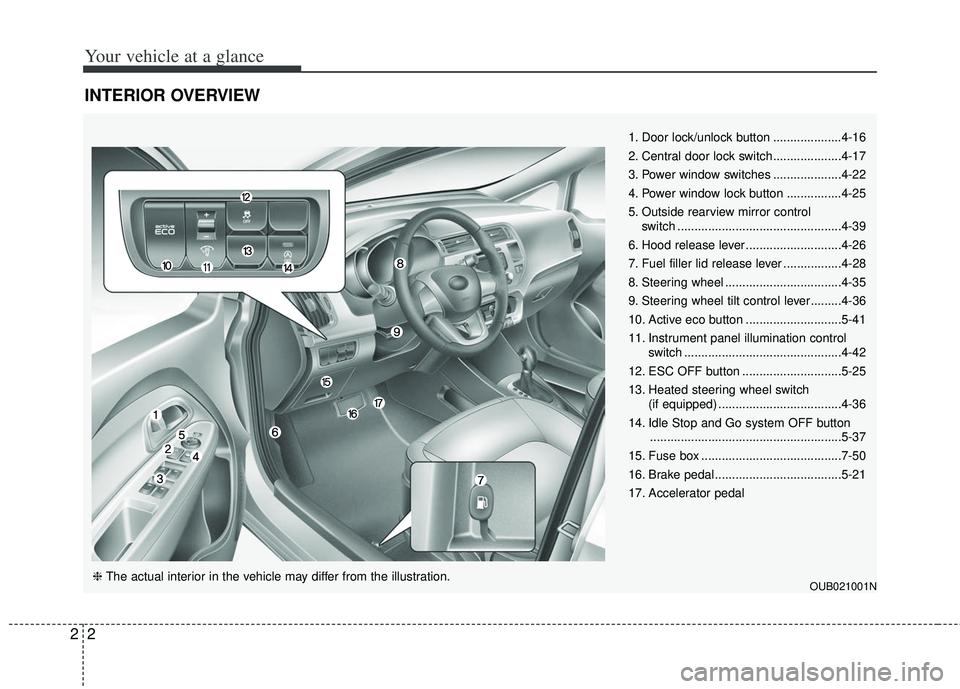
Your vehicle at a glance
22
INTERIOR OVERVIEW
OUB021001N
1. Door lock/unlock button ....................4-16
2. Central door lock switch....................4-17
3. Power window switches ....................4-22
4. Power window lock button ................4-25
5. Outside rearview mirror control switch ................................................4-39
6. Hood release lever ............................4-26
7. Fuel filler lid release lever .................4-28
8. Steering wheel ..................................4-35
9. Steering wheel tilt control lever.........4-36
10. Active eco button ............................5-41
11. Instrument panel illumination control switch ..............................................4-42
12. ESC OFF button .............................5-25
13. Heated steering wheel switch (if equipped) ....................................4-36
14. Idle Stop and Go system OFF button ........................................................5-37
15. Fuse box .........................................7-50
16. Brake pedal .....................................5-21
17. Accelerator pedal
❈ The actual interior in the vehicle may differ from the illustration.
Page 21 of 385

23
Your vehicle at a glance
INSTRUMENT PANEL OVERVIEW
OUB021002N
1. Instrument cluster.............................4-41
2. Horn .................................................4-37
3. Driver’s front air bag .........................3-41
4. Light control/Turn signals .................4-70
5. Wiper/Washer ...................................4-74
6. Ignition switch or ENGINE START/STOP button .................................5-4, 5-6
7. Hazard warning flasher switch ......4-70, 6-2
8. Audio ..............................................4-102
9. Climate control system .....................4-81
10. Shift lever ...............................5-12, 5-15
11. Steering wheel audio control........4-103
12. Passenger’s front air bag ...............3-41
13. Glove box .......................................4-92
14. Parking brake lever ........................5-22
15. Power outlet ...................................4-99
16. Cigarette lighter ..............................4-96
17. Seat warmer .....................................3-7
❈ The actual instrument panel in the vehicle may differ from the illustration.
Page 110 of 385
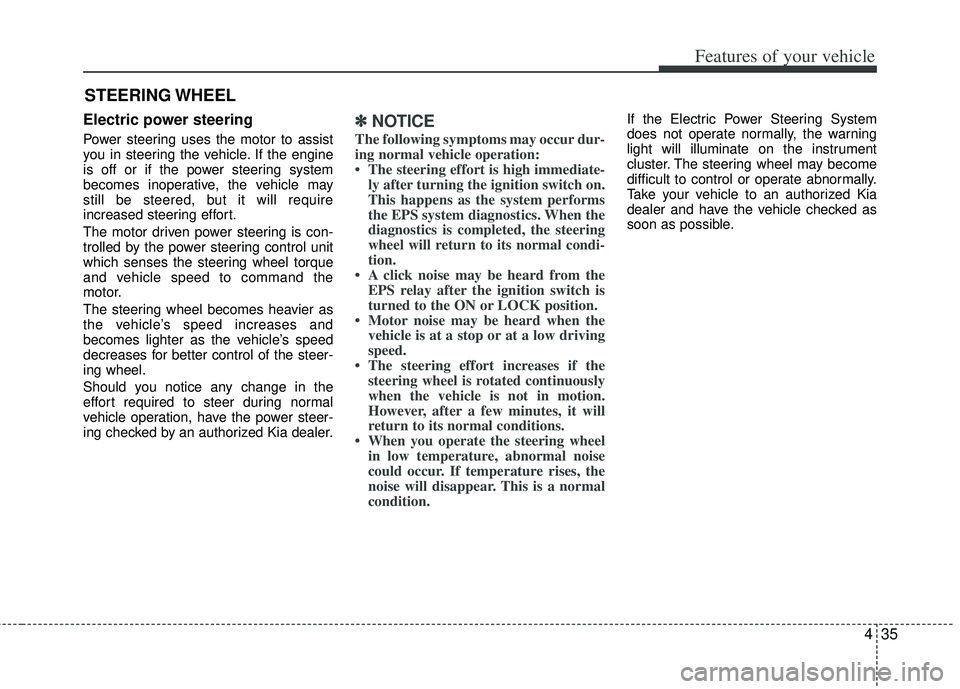
435
Features of your vehicle
Electric power steering
Power steering uses the motor to assist
you in steering the vehicle. If the engine
is off or if the power steering system
becomes inoperative, the vehicle may
still be steered, but it will require
increased steering effort.
The motor driven power steering is con-
trolled by the power steering control unit
which senses the steering wheel torque
and vehicle speed to command the
motor.
The steering wheel becomes heavier as
the vehicle’s speed increases and
becomes lighter as the vehicle’s speed
decreases for better control of the steer-
ing wheel.
Should you notice any change in the
effort required to steer during normal
vehicle operation, have the power steer-
ing checked by an authorized Kia dealer.
✽ ✽NOTICE
The following symptoms may occur dur-
ing normal vehicle operation:
• The steering effort is high immediate-
ly after turning the ignition switch on.
This happens as the system performs
the EPS system diagnostics. When the
diagnostics is completed, the steering
wheel will return to its normal condi-
tion.
• A click noise may be heard from the EPS relay after the ignition switch is
turned to the ON or LOCK position.
• Motor noise may be heard when the vehicle is at a stop or at a low driving
speed.
• The steering effort increases if the steering wheel is rotated continuously
when the vehicle is not in motion.
However, after a few minutes, it will
return to its normal conditions.
• When you operate the steering wheel in low temperature, abnormal noise
could occur. If temperature rises, the
noise will disappear. This is a normal
condition.
If the Electric Power Steering System
does not operate normally, the warning
light will illuminate on the instrument
cluster. The steering wheel may become
difficult to control or operate abnormally.
Take your vehicle to an authorized Kia
dealer and have the vehicle checked as
soon as possible.
STEERING WHEEL
Page 136 of 385

461
Features of your vehicle
Cruise indicator (if equipped)
CRUISE indicator
The indicator illuminates when the cruise
control system is enabled.
The cruise indicator in the instrument
cluster is illuminated when the cruise
control ON/OFF button on the steering
wheel is pushed.
The indicator goes off when the cruise
control ON/OFF button is pushed again.
For more Information, refer to “Cruise
control system” in section 5.Cruise SET indicator
The indicator illuminates when the cruise
function switch (SET- or RES+) is ON.
The cruise SET indicator in the instru-
ment cluster illuminates when the cruise
control switch (SET- or RES+) is pushed.
The cruise SET indicator does not illumi-
nate when the cruise control switch
(CANCEL) is pushed or the system is
disengaged.
Key reminder warning chime
(if equipped)
If the driver’s door is opened while the
ignition key is left in the ignition switch
(ACC or LOCK position), the key
reminder warning chime will sound. This
is to prevent you from locking your keys
in the vehicle. The chime sounds until the
key is removed from the ignition switch or
the driver’s door is closed.
Electric power steering(EPS) system warning light (if equipped)
This warning light illuminates after the
ignition key is turned to the ON position
and then it will go off when the engine
starts.
This light also comes on when the EPS
has malfunctioned. If it comes on while
driving, have your vehicle inspected by
an authorized Kia dealer.
Fuel cap open warningindicator
This warning light indicates the fuel filler
cap is not tighten securely.
Always make sure that the fuel filler cap
is tight.
SET
CRUISE
Page 214 of 385
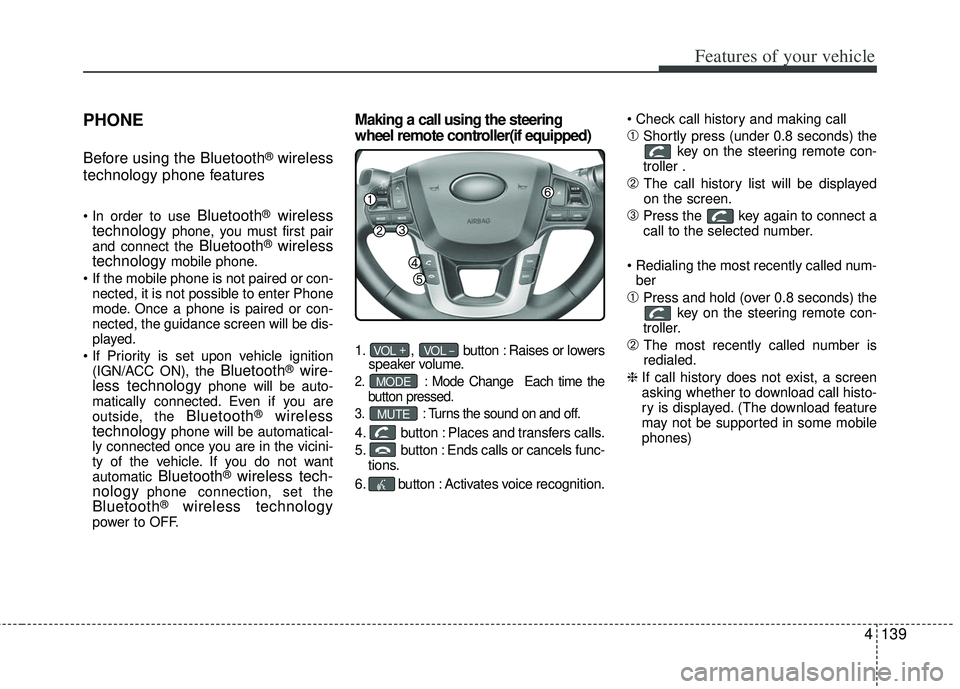
4139
Features of your vehicle
PHONE
Before using the Bluetooth®wireless
technology phone features
Bluetooth®wireless
technologyphone, you must first pair
and connect the Bluetooth®wireless
technologymobile phone.
If the mobile phone is not paired or con- nected, it is not possible to enter Phone
mode. Once a phone is paired or con-
nected, the guidance screen will be dis-
played.
(IGN/ACC ON), the
Bluetooth®wire-
less technologyphone will be auto-
matically connected. Even if you are
outside, the
Bluetooth®wireless
technologyphone will be automatical-
ly connected once you are in the vicini-
ty of the vehicle. If you do not want
automatic
Bluetooth®wireless tech-
nologyphone connection, set theBluetooth®wireless technologypower to OFF.
Making a call using the steering
wheel remote controller(if equipped)
1. , button : Raises or lowers
speaker volume.
2. :Mode Change Each time the
button pressed.
3. :Turns the sound on and off.
4. button : Places and transfers calls.
5. button : Ends calls or cancels func- tions.
6. button : Activates voice recognition.
➀Shortly press (under 0.8 seconds) the
key on the steering remote con-
troller .
➁ The call history list will be displayed
on the screen.
\bPress the key again to connect a
call to the selected number.
ber
➀Press and hold (over 0.8 seconds) the key on the steering remote con-
troller.
➁ The most recently called number is
redialed.
❈ If call history does not exist, a screen
asking whether to download call histo-
ry is displayed. (The download feature
may not be supported in some mobile
phones)
MUTE
MODE
VOL _VOL +
Page 244 of 385

521
Driving your vehicle
Power brakes
Your vehicle has power-assisted brakes
that adjust automatically through normal
usage.
In the event that the power-assisted
brakes lose power because of a stalled
engine or some other reason, you can
still stop your vehicle by applying greater
force to the brake pedal than you nor-
mally would. The stopping distance, how-
ever, will be longer.
When the engine is not running, the
reserve brake power is partially depleted
each time the brake pedal is applied. Do
not pump the brake pedal when the
power assist has been interrupted.
Pump the brake pedal only when neces-
sary to maintain steering control on slip-
pery surfaces.Wet brakes may impair the vehicle’s abil-
ity to safely slow down; the vehicle may
also pull to one side when the brakes are
applied. Applying the brakes lightly will
indicate whether they have been affected
in this way. To dry the brakes, apply them
lightly while maintaining a safe forward
speed until brake performance returns to
normal.
In the event of brake failure
If service brakes fail to operate while the
vehicle is in motion, you can make an
emergency stop with the parking brake.
The stopping distance, however, will be
much greater than normal.
BRAKE SYSTEM
WARNING- Parking brake
Avoid applying the parking brake to
stop the vehicle while it is moving
except in an emergency situation.
Applying the parking brake while
the vehicle is moving at normal
speeds can cause a sudden loss of
control of the vehicle. If you must
use the parking brake to stop the
vehicle, use great caution in apply-
ing the brake.
WARNING- Steep hillbraking
Avoid continuous application of the
brakes when descending a long or
steep hill by shifting to a lower
gear. Continuous brake application
will cause the brakes to overheat
and could result in a temporary
loss of braking performance.
CAUTION - Brake pedal
Do not drive with your foot resting
on the brake pedal. This will createabnormally high brake tempera-tures which can cause excessivebrake lining and pad wear.